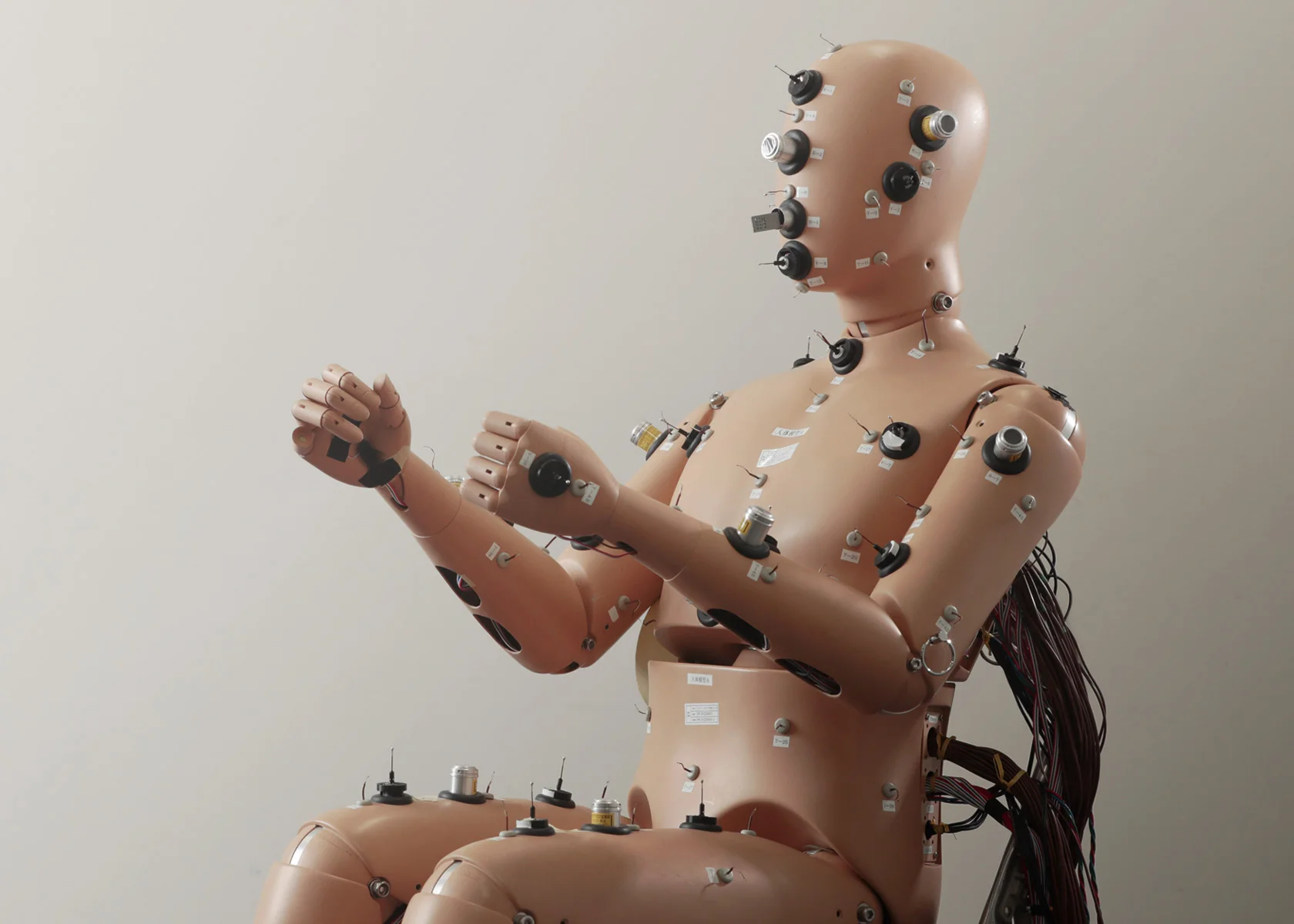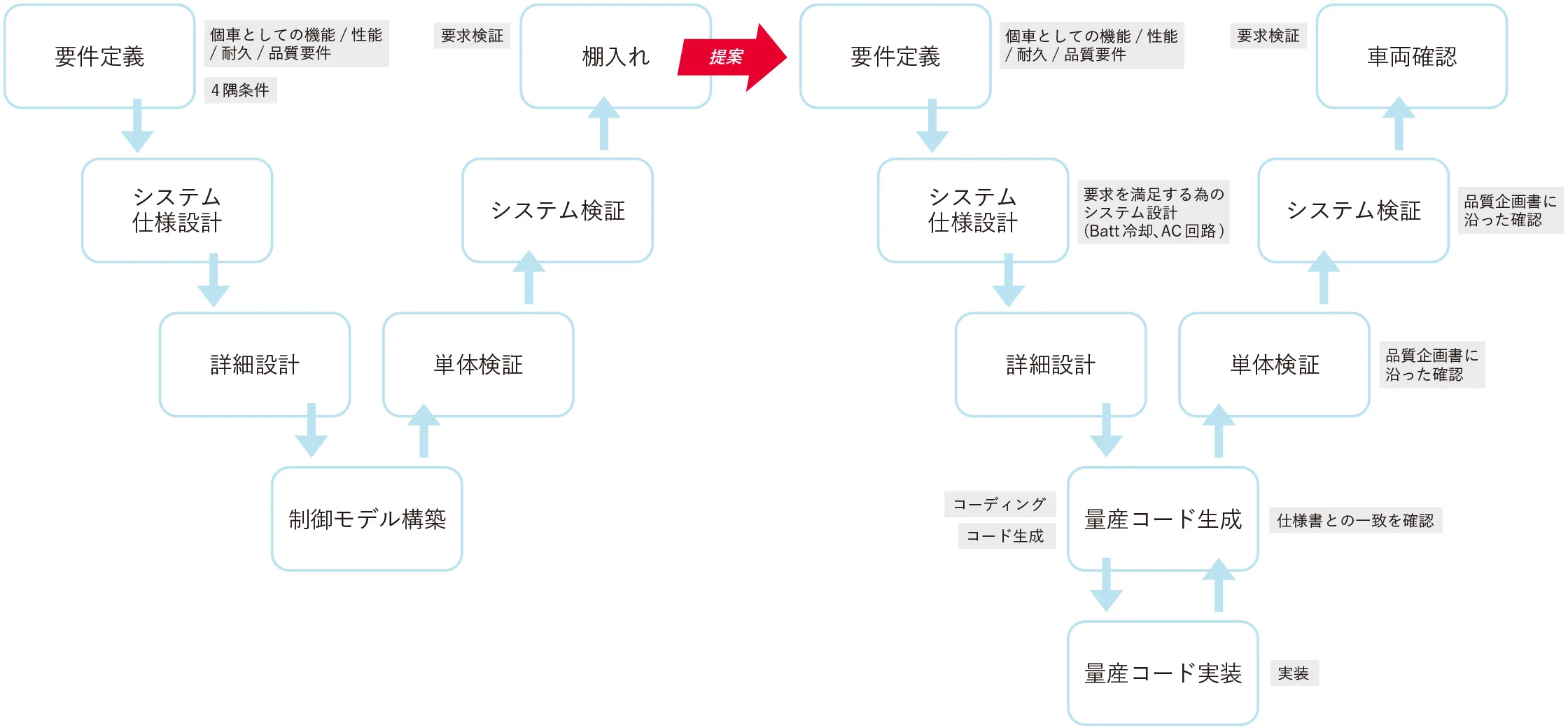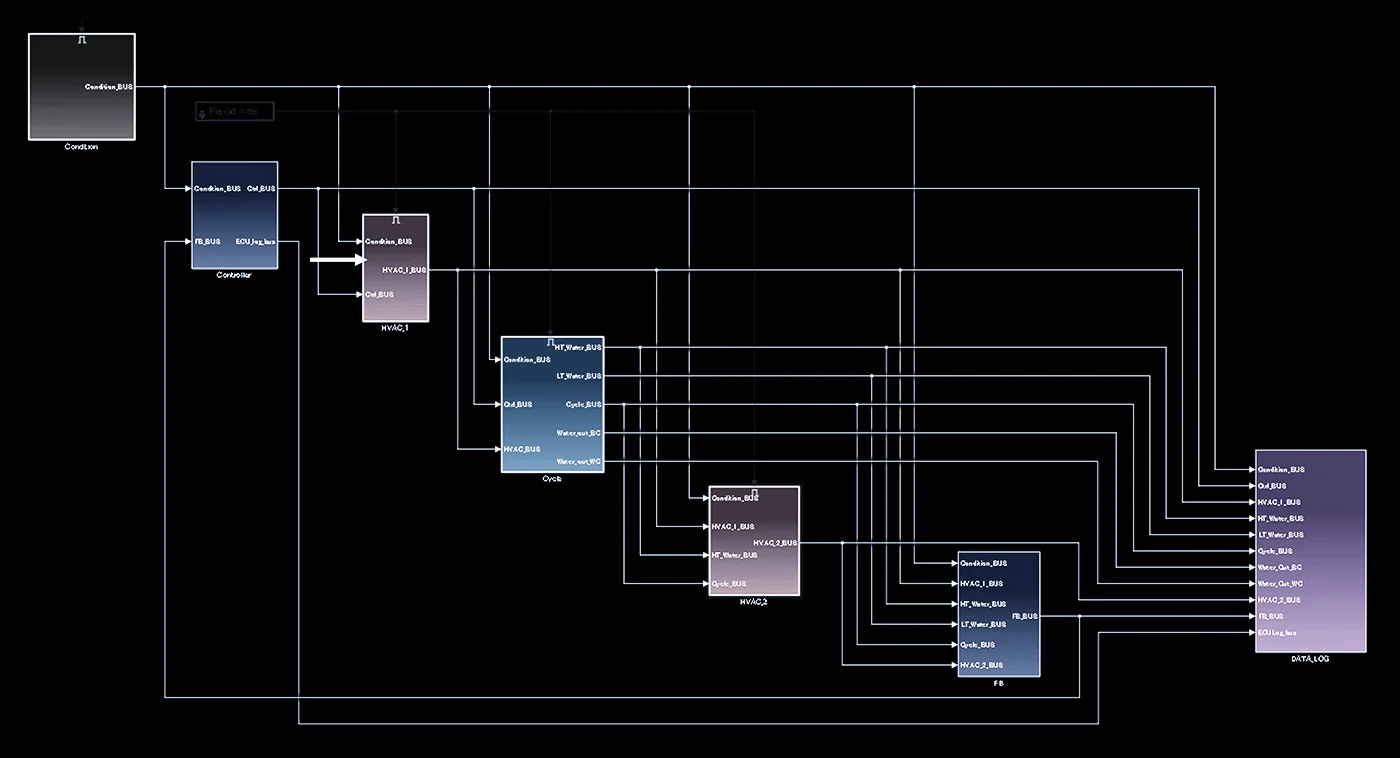

Jul 30, 2021
TECH & DESIGNCutting-edge simulations to revolutionize automotive air conditioning system development
Model-based development for greater development efficiency and advances
Automotive air conditioning systems not only make the in-car environment more comfortable, they also contribute to greater safety by ensuring visibility for the driver. Both hardware- and software-based control for ensuring comfort and safety are becoming increasingly complex as automobiles evolve, and the model-based development (MBD) approach is now more common among AC system developers. How will MBD change processes at the forefront of car AC development?
-
Thermal Systems Electronic Control R&D Div.Hiroyuki Tomita
Hiroyuki Tomita joined DENSO in 1983 and was tasked with designing automotive AC electrical components. Using this experience, from 1998 he moved on to specifications design and new-development operations for automotive AC electronic control units (ECUs). Currently, Tomita handles ECU specifications design.
-
Thermal Systems Electronic Control R&D Div.Takashi Kawai
Takashi Kawai studied information engineering and image recognition at university, and after joining DENSO in 2007 he began development and design work for automotive AC controllers, automated-driving software and auto-body software. In 2017 he returned to automotive AC controller development, for which he is currently using the MBD approach.
Contents of this article
How automotive air conditioning works
— AC systems are considered standard in automobiles, but I’ve heard their technologies are undergoing some major changes. Can you explain how car AC systems are controlled?
Tomita: Car AC systems are, at their core, quite simple. Various sensors are used to detect outside and inside air temperatures, amounts of sunlight, and so forth. Based on this information and the user’s temperature settings, the controller calculates the appropriate AC output temperature and air-volume to make the user feel comfortable. It also determines whether to use outside air or to recirculate internal air, as well as which air-outlet to use for sending air.
In addition, it is important for car AC systems to regulate humidity levels, because driving may become difficult or even impossible if the windows get too fogged up. So, even though the basic system is simple, it’s actually quite challenging to make the cabin environment comfortable in practice.
In today’s cars, it has become common to offer differing temperature-setting options for the driver and passenger sides, and some cars even offer variable temperature settings for the upper and lower body. On winter days when sunlight is strong, the system heats the area around the feet while sending cool air toward the face. Even when simply venting air without using any AC temperature adjustment, the ratios of air sent toward the feet, the windshield and so forth must be controlled at differing levels so that users remain comfortable and the windshield remains fog-free to enable safe driving.
— Have there been any major changes or advances in automotive AC systems themselves?
Tomita: Originally, car AC systems were designed to produce cooled air only. A compressor was used to cool the air, which was then mixed in appropriate amounts with heat generated by the engine. However, things changed when hybrid electric vehicles (HEVs), plug-in hybrid electric vehicles (PHEVs) and battery electric vehicles (BEVs) came on the scene.
HEVs these days increasingly use their battery for operations, meaning the engine is stopped frequently. Gasoline-powered vehicles use an engine-operated compressor for the AC system, but in HEVs an electrically operated compressor must be used instead, so electrical-compressor control is also required. PHEVs running in electric vehicle (EV) mode, as well as BEVs, don’t even have the option of using the engine as a heat source, so their AC system uses a heat pump instead, which is a device that compresses and expands refrigerant to exchange heat with the outside air.
With home-use air conditioners, it’s possible to switch between cooling and heating modes simply by running the refrigerant in the opposite direction, but with car ACs the humidity rises when the heater function is in use, causing the windows to fog up. Therefore, when the heater is on, the car AC must simultaneously activate the cooling function of the system to reduce humidity. To achieve this, some cars include a heater device for heating purposes that is separate from the heat pump system, and of course this additional device must also be controlled. Furthermore, we are also developing a system that offers dehumidification and heating at the same time in addition to standard heating and cooling by switching the direction of refrigerant flow.
— Trying to balance control of the additional heater and the heat pump system must be much more complex and challenging.
Tomita: That’s right. We developed an algorithm to decide, based on certain conditions, when to switch between the three operating modes—that is, heat-pump-based cooling and heating, and heater-based dehumidification heating. Moreover, BEVs and similar vehicle types require cooling of the battery when it gets too hot, or in the case of an HEV a switchover to engine power, so we have to work closely with the automaker to precisely design the specifications.
In fact, in order to optimize the vehicle environment for users, we use a “thermal manikin” which is a human-like mannequin with numerous temperature sensors attached, along with thermometers installed inside air-outlet. These carefully measure and analyze temperature characteristics, and my division uses the results to create the specifications for the AC system’s electronic control unit (ECU). The ECU specifications for a single vehicle model’s AC system take up about 2,000 pages on standard-sized printer paper, and the ECU’s programming code is then written based on these specifications.
What’s really difficult is that even a slight change in one vehicle component can affect factors such as airtightness, causing the specifications to change. Therefore, the vehicle has to be fully completed before we can carry out a proper AC system evaluation. Changes to AC system specifications are sometimes requested at the very final stage of the manufacturing process.

Increasing utilization of model-based development
— Improving user comfort and driving safety seems a very complex process.
Kawai: Automotive AC control system development is carried out using a V-model approach. Development starts with defining the requirements, followed by basic design, detailed design, and then control model creation. Next comes unit testing, integrated testing and system testing, followed by verification testing to ensure that ECU programming has been carried out correctly in accordance with the specification requirements. With car AC systems, the development process goes through this V cycle about three times in total.

— As car AC control becomes more complex, won’t development take even longer?
Kawai: That is one of our big challenges, and so we’ve been using MBD—model-based development. The “model” in MBD refers to the models used to show how systems are structured and operate. A controller model, for example, shows what types of calculations the ECU performs in response to certain inputs from sensors and the like, and then what types of output are sent to actuators such as the motor or compressor. Next, it shows how sensor inputs are received in response to actuator outputs, and how these inputs are sent to the controller.
— Can you simulate operations for the ECU, sensors, actuators and other AC control components using computer software?
Kawai: Yes, we can. When using the V-model approach in the past, it was necessary to manufacture a physical ECU in order to verify that it met all the defined requirements. However, by using MBD, we can carry out such testing on the computer, even after we have reached as far as the detailed design stage.
— But you still have to carry out tests on an actual physical ECU unit, right? How do you do that?
Kawai: We take the ECU model created in the simulation software and output its C-language source code, integrating it into an actual ECU unit. With older development approaches, C coding was carried out manually based on the specification documentation, but with MBD no coding by humans is required.
— So with MBD, you don’t use a physical unit, but instead carry out trial-and-error testing and development through the simulation software?
Kawai: That’s right. In the past, we had to create an actual ECU unit and deliver it to the customer for verification testing, and if there was an operational error we performed the V cycle again, and then sent the customer a new ECU unit, and then repeated it all again. In other words, we went through the same V cycle over and over using physical units each time. However, with MBD we can test the unit virtually on the computer, and if there are errors, make changes via the software. By carrying out smaller-scale correction loops in this way during development, we need to repeat the larger V cycle far fewer times.

— I imagine MBD greatly reduces development times.
Kawai: Well, our current MBD project is actually the first time we have used the approach for a mass-produced car model, so we don’t know by how much development efficiency will be improved in reality. However, I estimate it will reduce the development time by about half or three-fourths. Also, if we get requests for car-model customization in the future, we will be able to respond very quickly thanks to MBD.
— When do you plan to fully integrate MBD into development operations?
Kawai: We started our current mass-production-vehicle MBD project in 2018, but DENSO actually began using simulation-software-based MBD in-house more than 10 years ago, to develop basic technologies within the company. The models created in this manner were put into ECUs designed specifically for early-stage development purposes, which were used to create control mechanisms by trial-and-error for equipment and prototype vehicles for development use.
— Did you use any of those advance-development models for developing mass-production vehicles?
Kawai: Although we did carry out ECU modeling during early stage development, the framework used for integration during mass production is different, so we couldn’t use those early models directly. Instead, we created specification sheets on paper and ran them through the V cycle. In other words, the models differ at the upper-left and lower portions of the “V” in the V cycle.
— And did you achieve any technological breakthroughs?
Kawai: Not in terms of technologies, but our basic approach to system development has changed a lot. Previously, our main approach was to use tools optimized to each section of the final product, but we now use a “three pillar” approach that uses mechatronics, electronics and software technologies together.
In the coming years, software development will become an increasingly important part of the development process, so making software development operations more efficient will reduce our costs. That’s why DENSO as a whole has changed its approach, and now wants to use the same models for both early stage and mass-production development.
— In addition to using models in-house, does DENSO plan to share its models with other manufacturers during development?
Kawai: Actually, that’s already happening in our car AC development operations. When running simulations for an automotive AC system as a whole, we have to take into consideration DENSO-made ECUs and components as well as various other devices, ECUs and parts made by other companies. A fully operational AC system can only be realized by working with other manufacturers in this way, so DENSO and our partners share models and carry out MBD based on those collaborations.
Making the cabin environment more comfortable
— What kinds of things do you think MBD will make possible in the future?
Kawai: Our current model only re-creates a single part of the automobile, not the entire vehicle itself. It deals with very basic parameters such as temperature and humidity. However, a real-life driver or passenger uses all five senses to detect things within the car — an unpleasant noise or odor in the vehicle, for example, can be really unpleasant. Unfortunately, we still have to rely on testing using actual devices and vehicles for factors like smell and sound. In the future, once we can re-create those types of physical factors within the MBD process as numerical values, we should be able to test them via simulation models as well.
— Would you also be able to carry out model-based analyses for things like vibrations between the vehicle body and components?
Kawai: Yes, that’s a possibility. Changes in the car body produce changes in sound, and even though we currently check such things one by one using actual vehicles, we hope to be able to re-create them via computer simulations in the future.
— Can modeling also account for the differing, individual ways in which people sense and feel things inside the vehicle?
Tomita: Actually, some of our more recent research has focused on using infrared sensors to measure the skin temperatures of users seated in the vehicle so AC temperature settings can be controlled accordingly.
Kawai: If we can better understand the correlation between skin temperature and personal bodily sensation in the user, then we can integrate this into our models and design AC systems that are better suited to user needs.
— Do you think that in the future you’ll be able to carry out most development through modeling and simulations via computer software, and then complete the actual AC system by building just one or two physical prototypes?
Kawai: That’s the goal of our current efforts in MBD. Automobile production takes a lot of time and money, so one of our biggest goals is to complete cars while making the fewest possible physical things in the process.
— It seems like automobile production will become more software-based. Won’t this change the skills that engineers need?
Kawai: Even when using MBD, the development and production processes are not limited to software alone. An engineer must understand how both the hardware and software work, otherwise they cannot know whether the behavior of the simulation program is suitable or not. That’s why I think, moving forward, companies like DENSO will seek engineers who have a good understanding of the car AC system as a whole, and are able to use that knowledge to design software models.
In addition, there will be a lot more communication between upstream and downstream development processes as software becomes increasingly central to operations. People at all stages will need a good understanding of what others want to do, as well as the communication skills required to convey such things.
REACTION
Changing your "Can'ts" into "Cans"
Where Knowledge and People Gather.




Leave a comment